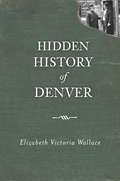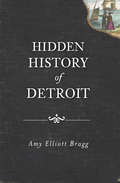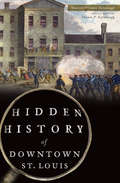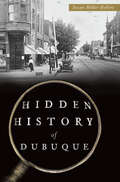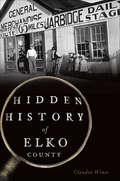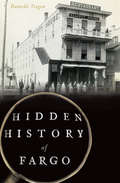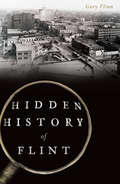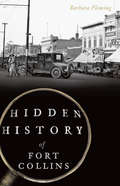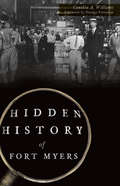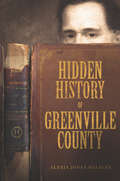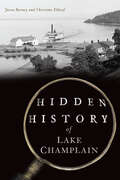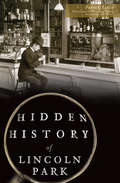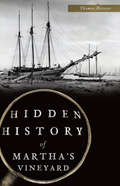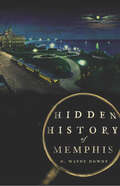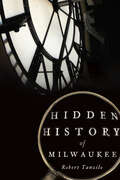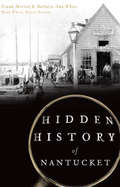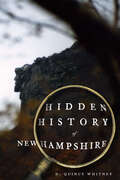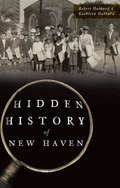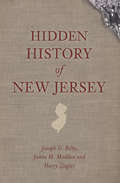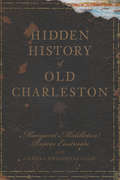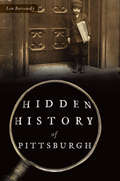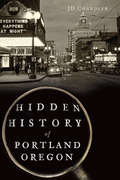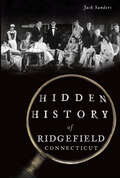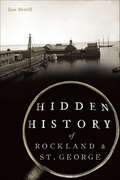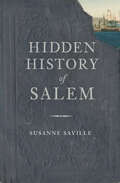- Table View
- List View
Hidden History of Denver (Hidden History)
by Elizabeth Victoria WallaceWhen prospectors set up camp on Cherry Creek in 1858, Denver emerged as a lightning rod for the extraordinary. Time has washed away so many unusual stories�from the dark days of nineteenth century Law and Order League lynchings and the KKK�s later rise and fall to the heroism of suffragettes and the touching plight of the gypsies. Elizabeth Wallace knocks the dust off these details and introduces readers to characters like world heavyweight boxing champion Charles L. �Sonny� Liston, hit-man turned rodeo promoter Leland Varain, aka �Diamond Jack,� and the city�s daring wall dogs, whose hand-painted building advertisements are fading reminders of a bygone Denver.
Hidden History of Detroit (Hidden History Ser.)
by Amy Elliott Bragg&“Engaging&” stories of what the Motor City was like before the invention of the motor, with photos and illustrations (Detroit Metro-Times). Long before it became the twentieth-century automotive capital, Detroit was a muddy port town full of grog shops, horse races, haphazard cemeteries, and enterprising bootstrappers from all over the world. In this lively book you&’ll discover the city&’s forgotten history and meet a variety of unforgettable characters—the argumentative French fugitive who founded the city; the tobacco magnate who haunts his shuttered factory; the gambler prankster millionaire who built a monument to himself; the governor who brought his scholarly library with him on canoe expeditions; and the historians who helped create the story of Detroit as we know it: one of the oldest, rowdiest, and most enigmatic cities in the Midwest.
Hidden History of Downtown St. Louis (Hidden History)
by Maureen O'Connor Kavanaugh Thomas P. KavanaughA reputation as the town of shoes, booze and blues persists in St. Louis. But a fascinating history waits just beneath the surface in the heart of the city, like the labyrinth of natural limestone caves where Anheuser-Busch got its start. One of the city’s Garment District shoe factories was the workplace of a young Tennessee Williams, referenced in his first Broadway play, The Glass Menagerie. Downtown’s vibrant African American community was the source and subject of such folk-blues classics as “Frankie and Johnny” and “Stagger Lee,” not to mention W.C. Handy’s classic “St. Louis Blues.” Navigate this hidden heritage of downtown St. Louis with author Maureen Kavanaugh.
Hidden History of Dubuque (Hidden History)
by Susan Miller HellertPoised on the banks of the mighty Mississippi River, Dubuque provided a vital entry point for westward expansion. Explorers, Native Americans, fur traders, lead miners and pilgrims all played a part in the little-known history of Iowa's Driftless Region. It was Dubuque that contributed the first military company in the country for service at the start of the Civil War. Jefferson Davis made a foray into the city in pursuit of lead miners. And gangster Al Capone reportedly used the Hotel Julien as a retreat and hideout. Uncover these lost stories and more with author and historian Susan Miller Hellert as she chronicles the fascinating and all-but-forgotten tales of Dubuque and the surrounding region.
Hidden History of Elko County (Hidden History)
by Claudia WinesElko County in Nevada's remote northeastern corner has long attracted independent, spirited individuals determined to carve out lives of their own. Born to former slaves, Henry Harris worked his way from John Sparks's house hand to one of the most respected buckaroos in the region. Pete Itcaina, the unlikely millionaire, once bought a local bar on the spot just to fire the bartender, who mistook Itcaina for a bum and refused to serve him. The beautiful cattle rustler Susie Raper charmed her way out of numerous arrests and trials, despite her trail of dead husbands. Local author Claudia Wines excavates sagas buried in the dust and probes conventional wisdom surrounding local legend.
Hidden History of Fargo (Hidden History)
by Danielle TeigenFueled by ambition and pipe dreams, Fargo�s earliest residents created an entire city out of the dust of a flat, desolate prairie. Roberts Street might not exist if it weren�t for Matilda Roberts, a resourceful pioneer wife who encouraged her husband�s cousin to set up his law firm on that important downtown thoroughfare. O.J. deLendrecie generated so much success through his retail store that he was able to buy President Theodore Roosevelt�s ranch in western North Dakota. Oliver Dalrymple may have been the bonanza farm king, but the better manager was his rival, Herbert Chaffee of the Amenia and Sharon Land Company. Author Danielle Teigen reveals the intriguing true stories behind many of the most engaging characters and what continues to make the �Gateway to the West� unique.
Hidden History of Flint (Hidden History)
by Gary FlinnBeneath Flint’s auto history lies a buried past. Local Civil War hero Franklin Thompson was actually Sarah Edmonds in disguise. Thread Lake’s Lakeside Amusement Park offered seaplane rides and a giant roller coaster partly built over the water before closing in 1931. Smith-Bridgman’s, the largest department store in town, reigned supreme for more than a century at the same location. And the city’s most prolific inventor, Lloyd Copeman, created the electric stove, flexible ice cube tray and automatic toaster. Gary Flinn showcases the obscure and surprising elements of the Vehicle City’s past, including how the 2014 water crisis was a half century in the making.
Hidden History of Fort Collins (Hidden History)
by Barbara FlemingFrom its Wild West days to the early twentieth century, Fort Collins boasted its share of colorful characters. British import Edith Boothroyd saved a mare from meeting a tragic fate after the bridge she and the horse were traveling across unexpectedly collapsed. In 1915, barnstormer Billy Parker built his first biplane in a local field. Happy Jack slipped away from prison after slyly convincing the jailer to loosen his restraints. And Francis Carter-Cotton left investors holding the bag when he fled to Canada after racking up $300,000 in debt. Barbara Fleming divulges these entertaining stories and more.
Hidden History of Fort Myers
by Cynthia A. Williams Denége PattersonAlthough best known as the winter home of Thomas Edison and Henry Ford, Fort Myers has one of the most engaging and extraordinary histories of any city in Florida. The spawn of a hurricane, Fort Myers began as a U.S. Army post during Florida�s Seminole Wars. During the Civil War, it became a battleground between Confederates and Yankees for cattle and, after the war, a gun-slinging cowboy town. New York cartoonist Walt McDougall blew into the area on a fishing trip, and his glowing description lured down other wealthy Yankee sportsmen who helped turn this isolated frontier town into a modern tourist destination. Historian and author Cynthia Williams explores the hidden stories behind the growth of this beautiful city.
Hidden History of Greenville County (Hidden History)
by Alexia Jones HelsleyHistorically, Greenville County owes much to its natural advantages of scenery, location and abundant water, but it has also benefited from its colorful characters, such as Richard Pearis, Vardry McBee, Richard Furman and the Earle family. Hidden History of Greenville County details the personalities, places and events that have given Greenville its progressive, diverse environment. Join archivist and history professor Alexia Helsley as she explores some of these individuals and their contributions, as well as little-known events in the area and the ever-fascinating "Dark Corner." From mansions to murders, learn things about Greenville County history that you've never encountered before.
Hidden History of Lake Champlain (Hidden History)
by Jason Barney Christine EldredLake Champlain is one of America's most historic waterways, but much of its history has remained hidden. With the arrival of Europeans, the lake became a vital route between the English in New England and the French in Quebec. Its isolated beauty contrasted sharply with the bloody military campaigns that unfolded there. While enormous forts were erected, colonial villages blossomed, and 18th century naturalist Peter Kalm spread the word of its bucolic charm. William Miller attracted large audiences as he preached that the world would end in the 1840s. Valcour Island developed its own commune, and when Prohibition took effect, the towns near the Canadian border became a hotbed of bootlegging. From presidential visits to shipwrecks, local authors Jason Barney and Christine Eldred chronicle some of the lake's lesser-known contributions to American history.
Hidden History of Lincoln Park (Hidden History)
by Patrick ButlerBefore Lincoln Park cemented its trendy reputation, plenty of odd and unruly history managed to settle into its foundation. A Viking ship, mob henchmen and ladies of the evening all took up residence in the same part of town where Dwight L. Moody went from selling soles to saving souls. Thanks to a Confederate ferryboat crewman, many of Lincoln's personal effects belong to the neighborhood named after him. Patrick Butler uncovers Lincoln Park's forgotten contributions to Chicago's heritage, from the "Pleasure Wheel" on Navy Pier to the city's cycling craze.
Hidden History of Martha's Vineyard (Hidden History)
by Thomas DresserBehind the mansions and presidential vacations of Martha’s Vineyard hide the lost stories and forgotten events of small-town America. What was the island’s role in the Underground Railroad? Why do chickens festoon Nancy Luce’s grave? And how did the people of the Vineyard react in 1923 when the rumrunning ship John Dwight sank with the island’s supply of liquor aboard? Delve deep below the surface of history to discover the origin and meaning of local place names and the significance of beloved landmarks. Celebrated local historian Thomas Dresser unearths the little-known stories that laid the foundations for the community of Martha’s Vineyard.
Hidden History of Memphis (Hidden History)
by G. Wayne DowdyA tour of the Tennessee city filled with famous faces, fascinating trivia, and forgotten lore—plus a former mayor&’s previously unpublished private papers. Step inside the fascinating annals of the Bluff City's history and discover the Memphis that only few know. G. Wayne Dowdy, longtime archivist for the Memphis Public Library, examines the history and culture of the Mid-South during its most important decades. Well-known faces like Clarence Saunders, Elvis Presley, and W.C. Handy are joined by some of the more obscure characters from the past, like the Memphis gangster who inspired one of William Faulkner's most famous novels; the local Boy Scout who captured German spies during World War I; the Memphis radio station that pioneered wireless broadcasting; and so many more. Also included are the previously unpublished private papers and correspondence of former mayor E.H. Crump, giving us new insight and a front-row seat to the machine that shaped Tennessee politics in the twentieth century. Includes photos
Hidden History of Milwaukee (Hidden History)
by Robert TanziloJoin a local history expert for an exclusive behind-the-scenes tour of Milwaukee&’s incredible past. Sail out to the Breakwater Lighthouse, scramble up the wings of the Milwaukee Art Museum, and dig up the city&’s roots on the corner of Water Street and Wisconsin Avenue. Seize the chance to do a little urban spelunking and explore basilicas, burial grounds, and breweries. Ring the bell in the city hall tower, and take a turn around the secret indoor track at a Montessori school. No space is off limits in these untold stories of the Cream City's most familiar places and celebrated landmarks, from Bobby Tanzilo of the popular OnMilwaukee website. Includes photos!
Hidden History of Nantucket (Hidden History)
by Frank Morral Barbara Ann WhiteThe celebrated history of Nantucket's great whaling days often overshadows the fascinating changes that took place in the years following. Discover the story behind the Nantucket Civil War Monument--and learn about some named on it, some left off and some who may not belong. Meet the Cold Water Army of seven hundred schoolchildren who paraded against King Alcohol in hopes that the island would become a temperance oasis. Little remains of the bathing pavilion and water slide of the long-lost town of Coatue that once had big plans for expansion. With surprising facts and captivating tales, authors Frank Morral and Barbara Ann White explore these and other lost accounts of the faraway island.
Hidden History of New Hampshire (Hidden History)
by D. Quincy WhitneyA collection of colorful stories about some of New Hampshire&’s most notable newsmakers and remarkable historic events. Includes photos. Hidden in the cracks and crevices of the Granite State are the stories of pioneers who pursued their passions, creating legacies along the way. Compiled by a Smithsonian researcher and former Boston Globe contributor, this treasury includes tales of: the mountain man who became an innkeeperthe &“Bird Man&” who took his passion to the White Housethe gentleman who ascended the highest peak in the Northeast in a steam-powered locomobilethe story of one skier&’s dramatic win at the 1939 &“American Inferno&” Mount Washington racethe Shaker Meetinghouse, built in just one day, in complete silencethe gallant efforts to save the Old Man of the Mountainand much more
Hidden History of New Haven (Hidden History)
by Robert Hubbard Kathleen HubbardThe celebrated history of New Haven often overshadows its fascinating and forgotten past. The Elm City was home to America's first woman dentist, an architect who designed the tallest twin towers in the world and a medical student who used toy parts to create an artificial heart pump. A city noted as the home of one of the top universities in the world, New Haven is also home to the third-oldest independent school in the United States, the first African American to receive a PhD degree and the founding of what would become the largest Catholic fraternal benefit society in the world. The city's share of disasters includes Connecticut's worst aviation crash, a zookeeper who was mauled to death and a fire at the Rialto Theater. Local authors Robert and Kathleen Hubbard reveal the rich and fascinating cultural legacies of one of New England's most treasured cities.
Hidden History of New Jersey (Hidden History Ser.)
by Joseph G. Bilby James M. Madden Harry ZieglerThe obscure people and events that helped make the Garden State the place it is today—from ghosts to governors, battles to boardwalk attractions. Explore the lesser-known stories that make up New Jersey&’s compelling hidden history. Uncover the meaning of &“Jersey Blues,&” celebrate some of the state&’s bravest Revolutionary and Civil War soldiers, and investigate Jersey City&’s most infamous ghost. From the inferno that engulfed Asbury Park to the benevolent side of Frank Hague to the equestrienne who plunged forty feet into a pool of water on horseback in Atlantic City, rediscover these and many other events from New Jersey&’s storied past. Includes photos!
Hidden History of Old Charleston (Hidden History)
by Margaret Middleton Eastman Edward FitzSimons GoodFrom the Lowcountry's first recorded duel to old-fashioned summers at the "hottest spot in town", these pages will captivate you with stories of people, events and places that have all but vanished from memory. Find out the real history behind some of Charleston's beloved mansions and learn about the early plantations and their owners. Join the authors as they relate the riots and romance, the preservation and politics - and even a ghost story - from Charleston's hidden history.
Hidden History of Pittsburgh (Hidden History)
by Len BarcouskyWhen Mark Twain visited in 1884, he claimed to spy a little bit of hell in Pittsburgh's smoky appearance. Twain's observations are among the many riveting firsthand accounts and anecdotes to be found in the archives of the Pittsburgh Post-Gazette. The Great War hit home after the sinking of the Lusitania, which carried more than a dozen Pittsburgh residents. A few years later, cheering throngs of black and white residents lined downtown streets to welcome African American soldiers returning home from the conflict. The Ringling Brothers Circus held its last outdoor performance here in 1956 and left eight hundred show workers without jobs in the city. With these stories from the archives and more, veteran journalist Len Barcousky shines a light on the hidden corners of Pittsburgh's history.
Hidden History of Portland, Oregon (Hidden History)
by Jd ChandlerIn this engaging narrative, author JD Chandler crafts a people's history of Portland, Oregon, sharing the lesser-known stories of individuals who stood against the tide and fought for liberty and representation: C.E.S. Wood, who documented the conflict between Native Americans and the United States Army; Beatrice Morrow Cannady, founding member of the Portland NAACP and first African American woman to practice law in Oregon; women's rights advocate Dr. Marie Equi, who performed abortions and was an open lesbian; and student athlete Jack Yoshihara, who, in the wake of Pearl Harbor, was barred from participating in the 1942 Rose Bowl. From scandal and oppression to injustice and the brink of revolution, join Chandler as he gives voice to the Rose City's quiet radicals and outspoken activists.
Hidden History of Ridgefield, Connecticut (Hidden History)
by Jack SandersTime nearly erased many astounding tales and unexpected anecdotes from Ridgefield's history. Its colorful characters include a widow who built a landmark Manhattan hotel, her neighbor who invented one of the first "helicopters" and a CIA operative who helped one thousand Americans flee Saigon at the end of the Vietnam War. Lesser known are the stories of the Ridgefield artists who gave the world Superman and Lowly Worm and brought the Wild West to life. One local writer helped make Hawthorne famous, while another penned thousands of hymns still sung around the globe. Join retired newspaper editor Jack Sanders as he uncovers nearly forgotten people and moments of Ridgefield's past.
Hidden History of Rockland & St. George (Hidden History)
by Jane MerrillDown East Maine is well known for its breathtaking scenery and art museums. However, much of the history in the traditional mining and fishing area of Rockland and St. George remains untold. Hanson Gregory from Clam Cove invented the donut. Mary Brown Patten sailed a clipper around Cape Horn. Captain Albert Keller was shipwrecked on Easter Island and Effie Canning of Rockland composed the lullaby "Rock a Bye Baby." Captain Charles Holbrook of Tenants Harbor and his ship, the Hattie Dunn, fell victim to a German U-boat in the Atlantic. Local author Jane Merrill uncovers the forgotten stories and personalities that bring this unique area's history into focus.
Hidden History of Salem (Hidden History)
by Susanne SavilleThere&’s more to this Massachusetts seaside town than witches, including a past rich in maritime exploits, literary endeavors, and even ghost cats. Salem, nestled along the rocky coast of Massachusetts, has long been synonymous with witches, despite efforts to emphasize other aspects of the city&’s rich history. In this fascinating collection of stories, author Susanne Saville sheds light on the forgotten moments of this noteworthy New England community. Discover Salem&’s profitable &“Age of Sail,&” the important role coffeehouses played during the American Revolution, the scandalous life of Richard Crowninshield Jr. and the unforgettable writer Nathaniel Hawthorne. These revealing stories will not leave the history of Salem in the shadows for long. Includes photos!
